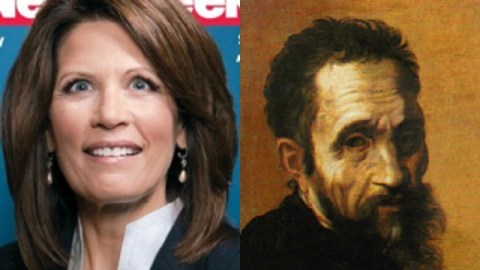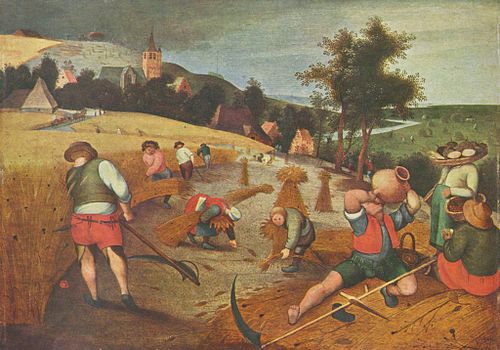Michele Bachmann Versus Michelangelo

After winning the Iowa straw poll and becoming the early leader for the GOP nod for the 2012 presidential race, Michele Bachmann (shown above, on the left) might be looking for new foes to topple. Mitt Romney might be good enough for some people, but Michele’s aiming for true giants among men and women. Thanks to Ryan Lizza’s piece in the August 15, 2011 issue of The New Yorker, we might guess at Bachmann’s next target—Michelangelo (shown above, on the right)! Lizza explains how the influences that helped shaped Bachmann’s world view conflict with the Renaissance world view that Michelangelo, da Vinci, and others forged and much of Western civilization ever since has embraced. People usually ask candidates where they stand on economics, education, health care, and other issues. Is it finally necessary to ask where they stand on the Renaissance?
Bachmann and her husband credit theologian Francis Schaeffer’s film series titled How Should We Then Live? as one of the seminal influences on their thinking. As quoted by Lizza, Bachmann calls Schaeffer “a tremendous philosopher” who “took Christianity beyond the Bible” and showed her “how the application of living according to Christian principles has helped the culture for the better.” “In the films,” Lizza writes, “Schaeffer… condemns the influence of the Italian Renaissance, the Enlightenment, Darwin, secular humanism, and postmodernism.” In a pivotal scene, Schaeffer stands beside Michelangelo’s David to “[explain] why, for all its beauty, Renaissance art represented a dangerous turn away from a God-centered world and toward a blasphemous, human-centered world,” Lizza continues. Thus, the Renaissance becomes an intellectual harlot tempting us away from the God-centered world of the pre-Renaissance days. Of course, those good old, God-centered days are often called the “Dark Ages,” when ancient Greek and Roman humanist culture fell into obscurity and almost total annihilation. Does Bachmann want to knock David off his pedestal and return us to a God-centered, “better” culture? Will that look like a new “Dark Ages” for America?
It’s a big leap, obviously, to go from the ideas of an influence, even a major one, to the potential actions of a follower, but when you’re talking about a possible presidential candidate and a centuries-long turning back of the cultural clock, such questions need to be asked. Politicians often pick on artists to score political points. Chris Ofili’s elephant dung-covered painting The Holy Virgin Mary provided plenty of fodder for Rudy Giuliani to make a splash during his New York City mayoral reelection run in 1999. Dana Rohrabacher, Jesse Helms, and others attacked funding for Robert Mapplethorpe’s photographic exhibitions and incited homophobic hysteria in the U.S. Congress. What separates Bachmann’s distaste for Michelangelo and company from those previous protests, aside from the posthumous element, is just how central that disdain is to her vision. With Rudy and Jesse, you always got the sense that the theatrics were nothing more than a sideshow for the faithful. With Bachmann, I suspect that this might be the main event.
So, should Michele Bachmann be grilled by the media on her “Renaissance problem,” if you think, like I do, that it is a problem? Can we accept a leader who rejects the enlightenment humanism that influenced Thomas Jefferson and other Founding Fathers when they helped begin this experiment called America? Or do all those ideas belong on the dustbin of history? If the choice is Michele or Michelangelo, whom should we choose?





